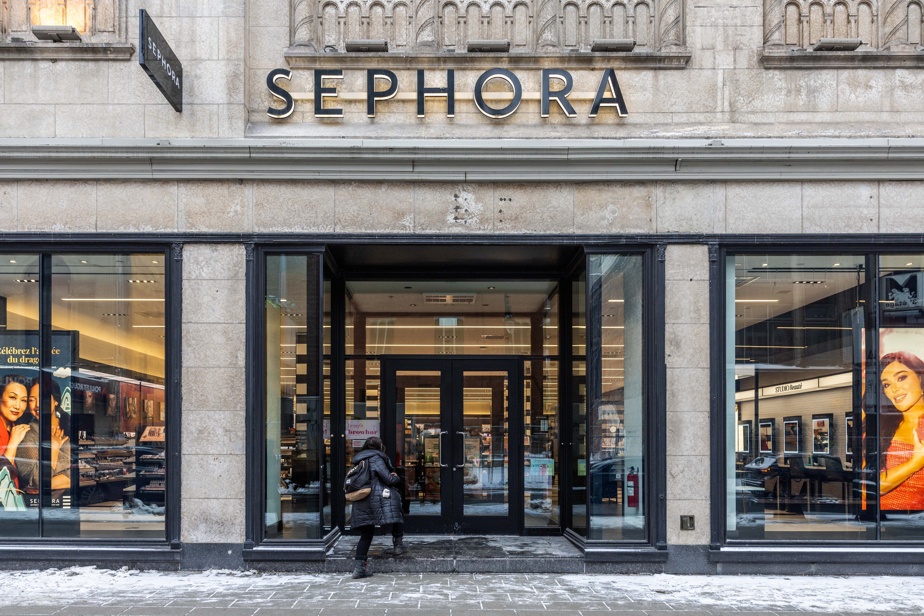Children’s craze
Friday was an educational day in many schools, and it appeared at the Sephora cosmetics store in Galeries d’Anjou, in Montreal. Accompanied by her 6 and 7 year old daughters, Stéphanye Dicaire left the store with gifts to give to her sister… and a cautious look. “My daughters would have bought everything in the store,” confides the young mother, who was content to offer them a gloss. “They see the products on TikTok,” she explains. I’m not stopping them from looking… but I’m wondering. » At Sephora, The Press also encountered 13-year-old girls, including the trio made up of Chloé, Florence and Mireille, who came to try products. “I like it, but I understand that it’s useless. We get influenced,” Florence concedes spontaneously.
Sephora Kids
Sephora Kids
-

IMAGE FROM THE TIKTOK ACCOUNT @KIERSTYN
A demo bottle of Drunk Elephant
-

IMAGE FROM THE TIKTOK ACCOUNT @VICKY87
Open products
1/2
The growing number of children in Sephora stores seems to be creating a stir in the United States. TikTok users (some of whom claim to be employees of the chain) denounce the lack of good manners of certain “Sephora Kids”, who unscrupulously destroy the products on display. “They were raised by iPads. They are not properly socialized,” says a TikToker. “But where are their parents? », exclaims another. What about in Quebec? Sephora’s communications department in the United States did not return a call The Press, but a Montreal saleswoman told us that in her store, “it’s really less worse than on social networks.” “Most children come with their parents,” she explained.
Not contraindicated, but…

PHOTO MARTIN TREMBLAY, THE PRESS
Young customers try on the items on display.
Dermatologist Sophie Vadeboncœur is well placed to observe girls’ current craze for makeup and “very complex skincare routines.” She sees patients aged 10, 11 with skin conditions (eczema, psoriasis) “showing up with suitcases of products”. “Marketing and social media are so powerful,” she says. Is it contraindicated? “If you have normal skin, not prone to eczema or acne, there is no contraindication to using most of these products,” replies the DD Vadeboncœur, which advises children against products that contain acids, retinol or a lot of fragrance. “But is it necessary? Absolutely not. Normal skin does not need much other than being cleansed, hydrated and protected from the sun,” emphasizes the D.D Vadeboncœur, which reminds us that good products for sensitive skin can be found in pharmacies.
The role of networks
It’s not new that girls want to imitate older ones. And that’s normal. The author of the essay Made up, Daphné B., remembers buying her first “expensive product” at 13 – a Lise Watier blush. “At that age, makeup allows you to embody the person you are becoming,” she illustrates. But things have changed since his childhood. “The new thing is that videos and images that young people consume for entertainment are today modeled around beauty products,” underlines Daphné B. The editor-in-chief of the magazine Vero, Théo Dupuis-Carbonneau, notes other differences: the price of coveted items and the presence of powerful ingredients in certain products. “In our time, we collected $3 lip balms,” recalls the 32-year-old.
Influencers

IMAGE TAKEN FROM THE TIKTOK ACCOUNT @HELIN DOSKI
A content creator shares her thoughts on a Drunk Elephant product.
The alpha generation falls for specific products for various reasons: fun packaging, a luxurious appearance, an associated public figure. They thus covet “anti-pollution sun drops” at $50, a “lip oil” at $54, an “eyebrow gel” at $33… Cosmetics companies do business with content creators to promote their products in line. “When children see young, enthusiastic women speaking highly of these products, it fuels their desire to have them,” summarizes Théo Dupuis-Carbonneau. Daphné B. thinks of the videos ofunboxingto criticism, to hashtag “Get ready with me” (the morning routine) or even the “dupe” culture, for duplicate (find similar products at a lower cost). “It’s aspirational,” summarizes Daphné B. “When you look at that, you also imagine yourself creating content. Buying lip gloss gives you the opportunity to talk about it yourself. »
How to react ?

PHOTO GRAHAM HUGHES, THE CANADIAN PRESS
Customers line up at Boxing Day to Montreal.
It is tempting to adopt a strong stance towards this trend, but everything is not black and white, believes Emmanuelle Parent, general director and co-founder of the Center for Online Emotional Intelligence (CIEL). Digital technology, she recalls, can support the development of creativity and even identity among young people. “The areas of concern are skin risks, product cost and body image issues,” she says. Daphné B. reminds us that the faces put forward on the platforms are filtered faces, or illuminated by lights which camouflage imperfections. Parents therefore have an educational role to play with their children, helping them, without making them feel guilty, to separate the real from the virtual and to understand how platforms and influencer marketing work. Parents can also help their children identify the source of their desire for cosmetics, believes psychologist Lory Zephyr. “Does that necessarily mean we’re not going to buy them for him?” Not necessarily, but the parent can set a limit on price,” she concludes.
